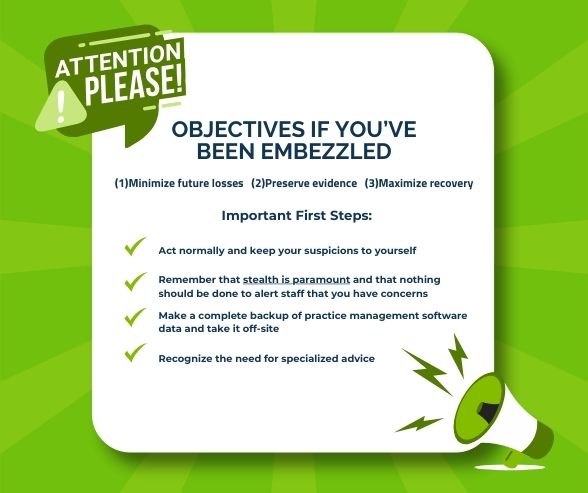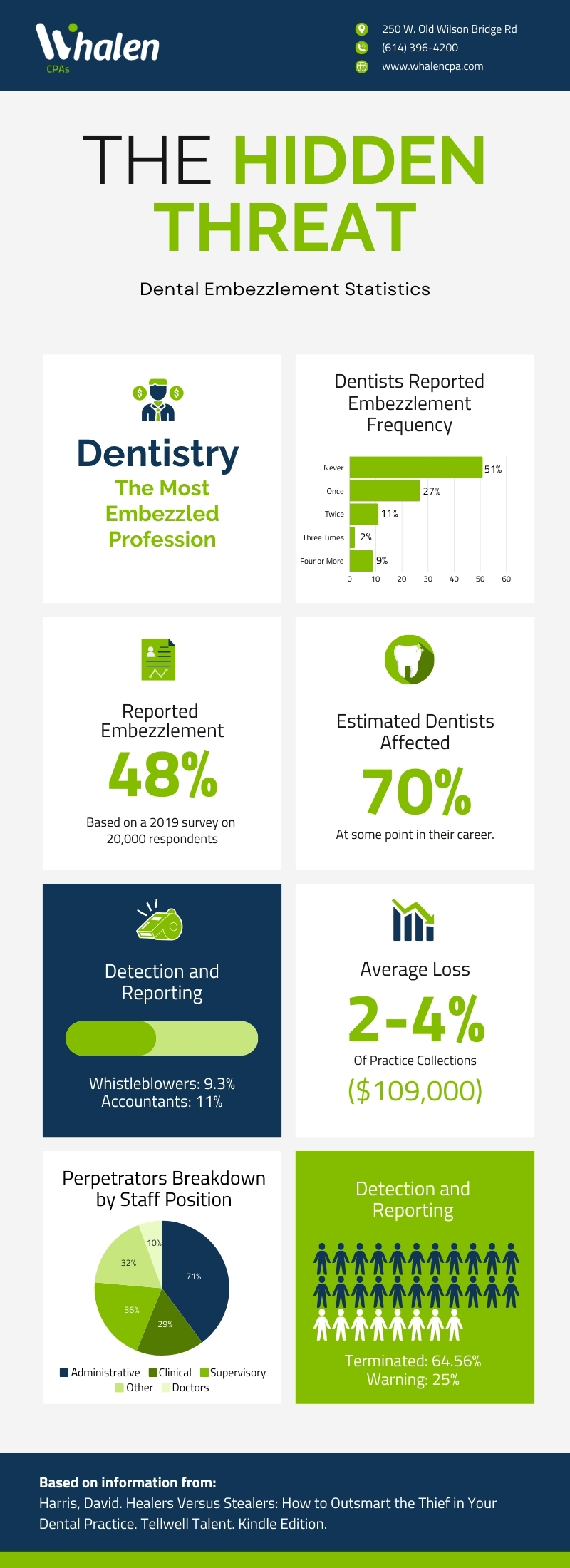How to Design an Embezzlement Resistant Office
Parts 1 and 2 of our embezzlement series discussed who embezzles and why. It also revealed the embezzled owner’s core problem: a lack of appropriate oversight. In this third and final part, we will provide essential tips on developing embezzle-resistant offices through effective revenue cycle management.
Can You Prevent Embezzlement?
In Healers versus Stealers: How to Outsmart the Thief in Your Dental Practice (2023), David Harris, CEO of Prosperident, a dental embezzlement investigation company, says embezzlement is a premeditated crime, not a crime of opportunity. That is, embezzlers don’t decide to steal impulsively; they look for ways to commit the fraud they have determined to commit. Thinking about embezzlement as deliberate frees owners from spending extraneous time on prevention strategies and more time on functional oversight of their companies.
Embezzlement-Resistant Offices: Hiring Practices Overhaul
Designing an embezzlement-resistant office starts with clearly understanding that some embezzlers have planned to steal from you even before you hire them. Harris calls this subset “zero-resistance employees.” These employees look for oversight breaches to green-light their intended theft. The best way to avoid these embezzlers is to pre-screen applicants through a rigorous hiring process (Harris, 2023). To evaluate your current employees, Harris suggests that owners look for ethical lapses on the job or for high-risk behaviors off the job. Gambling, alcohol or drug use, unstable personal lives, or frequent moving can signal problems that may make embezzlement attractive to some (Harris, 2023).
Suppose you have previously exercised little (or no) oversight in hiring. In that case, Harris (2023) suggests that, in addition to considering whether the potential hire is competent and fits in with the office’s culture, you consider a fundamental question: Is everything the applicant is telling me really the truth? Dentists often hate hiring and are lax in following a thorough hiring process. Repeat embezzlers take advantage of this laxity as an invitation to present themselves as just what the frazzled dentist needs. Harris (2023) suggests the following tips:
- Think of hiring as a part of owning a business: Remember you are a dentist and a business owner. Hiring is part of business, and the new employee will influence the course of the practice. Take the time to hire carefully.
- Enter the hiring process with an investigator mindset: Savvy owners try to uncover what the applicant doesn’t want to divulge. A recent survey reported by CNBC.com (2022) found that over 55% of respondents admitted to lying on their resume at least once. Common resume lies include falsehoods about skills, previous work experience, degrees, personal details, salary, and employee references.
- Don’t trust your perceptions: 1 in 4 adults have a criminal record. You probably think you don’t even know someone with a criminal record or that you are a good judge of character. Harris (2023) admits that not all criminal records are instant barriers to hiring. Still, owners should take the time to uncover an applicant’s record and determine if the offense has unwanted implications for the safety of the other employees, patients, and office assets. Trusting your impression of an applicant is a sure-fire way to get deceived.
- Become a proactive employer: Don’t toss the unsolicited resumes in the trash if you are not actively hiring. Take time to evaluate the resumes and file the ones that seem a good fit for your office. You may need to add to your current employee pool and will have the opportunity to reach out to someone who may be willing to come and work with your team.
- Look for hires with good people skills: Most dentists want a quick learning curve for the new hire, so experience in a dental setting gives a candidate the edge. Harris (2023) suggests that offices hiring for public-facing roles may find excellent candidates in other industries. Computer software skills are probably trainable compared to trying to teach someone to be customer service-minded.
- Do proper employment checks: A background check for all potential employees is a must, says Harris (2023); however, how that is accomplished varies by state. To avoid HR violations, check with an employment attorney or an HR specialist to determine the appropriate guidelines for your state. A credit check is advised if the employee will work with any portion of the revenue cycle. Consult an HR advisor or employment attorney to learn more about how credit checking is handled in your state. Low credit ratings should not necessarily disqualify an employee if the circumstances are understandable; however, owners can arm themselves with information and use discernment to determine if they will proceed with hiring.
- Scrutinize and call references: The study reported by CNBC.com (2022) identified 21% of people falsifying references. This may take the form of providing phone numbers of friends or relatives who give glowing recommendations or pretending the former employer cannot provide references because they are not in business or deceased, says Harris (2023). Instead of using the provided numbers to speak with former employers, Harris (2023) suggests looking up the number for the business and calling. This strategy will end-run any deception for checking references.
- Verify credentials. The study reported by CNBC.com (2022) found that 41% of applicants lied about their college degrees or equivalent. It may be cumbersome, but owners should verify the applicant’s degrees, licenses, and permits. It is important to remember that, should the employee perform procedures outside their scope of licensure, it could cause problems for the owner.
- Look for inaccuracies: Attention to detail is the crown jewel in most offices. The resume is an applicant’s first point of contact, so most people want to make a good impression. Resumes with jarring grammar or misspelled words signal the applicant is not attentive to details even when trying to put their best foot forward.
- Scan social networking sites: Social sites are great for identifying a candidate’s interests, lifestyle, and behavior outside of the interview.
Oversight
Daily Oversight
Once hiring processes are in order, owners can reconfigure their office oversight procedures. We recommend starting your oversight makeover by dictating the treatment to the assistant for entry into the practice management software while still in the operatory. Hygienists can also employ the same data entry method for their treatment. This is the most accurate way to ensure the patient’s file records the correct treatment for that visit. At the end of the day, Harris (2023) recommends that providers print their own day sheets to verify the treatment entry. Once providers approve the data, the owner should review the day sheet report, initial it, and store it securely. This first step prevents an embezzler from only reporting a “clean” subset of transactions.
Next, scan the day sheet to ensure each patient has a fee charged for the visit unless it is for no-charge visits, such as surgery follow-ups. Be sure to review any fee adjustments. Harris (2023) warns that substituting an adjustment code for a payment code is a common theft-concealment tactic. Harris (2023, p. 138, Kindle edition) says, “Whatever the cause of the adjustment, it represents money out of your pocket, and for that reason, it requires scrutiny comparable to if you were writing a check for the same amount.”
Monthly Oversight
At the end of the month, dentists should print a monthly summary report from their practice management software and compare it to the sum of the day sheets. Whalen can provide a simple spreadsheet for owners should they need extra help. The sum of the individual day sheets should exactly match the month-end report. After verifying the month’s totals, owners should compare these to the bank statements. Whalen has developed standard operating procedures for dental practices to help you complete your monthly oversight duties. If you’d like to learn more about implementation and how oversight can help you, click here for your free copy.
If You Think You Have Been Embezzled
If you believe you are a victim of embezzlement, it is crucial to remain calm. Harris (2023) offers these suggestions for appropriate action:
Summary
Embezzlement in dental offices is rampant. Besides the monetary toll on the practice, owners and staff members must deal with feelings of betrayal and grapple with extending trust to new team members. While owners cannot prevent embezzlement from happening, developing and utilizing oversight strategies can speed up the detection of the crime and help the office move forward successfully.
Resources
Harris, D. (2023). Healers versus stealers: How to outsmart the thief in your dental practice. Tellwell Talent. Kindle Edition.
Schiff, M. & Martin, M. (2022, December 20). Over 55% of people admit to lying on their resume at least once-here are the 8 most common lies. CNBC.com. Over half of Americans admit to lying on their resume (cnbc.com)






